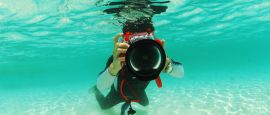Get out into the heart of the Rock Islands aboard a sailing yacht or dive liveaboard. Spending a few days aboard a gently rocking ship, moving from one remote, idyllic island to another is a truly memorable way to experience Palau's natural beauty and its most memorable dive sites.
Palau things to see and do
Tourist offices
Address: PO Box 256, Koror, Palau
Tel: 488 2793/1930.
www.visit-palau.com
Get active with one of the many watersports on offer. Choose from snorkelling trips, sea kayaking, sailing, sportfishing, surfing and of course diving and get out into the heart of the Rock Islands. There are several high quality outfits that offer a variety of trips and tours.
Most people use Koror as a stepping-stone to explore the rest of Palau. But hang around in the capital, the busiest centre in the islands, and you will find many craft shops, a handful of local restaurants and some lively bars, which serve up an authentic slice of Palauan culture.
Discover more about Palau's rich cultural heritage by paying a visit to the cultural centre, funded by a $2.5million grant from China. Palauan culture is matrilineal and the centre was founded by a group of visionary women who aim to preserve local traditions and educate locals and visitors alike.
Enjoy Palau's many and varied dive sites – considered some of the best in the world – including the famous Blue Corner. Other top sites are Ngemelis Wall, aka the Big Drop-off; the German Channel, known for its manta rays; Siaes Tunnel, an underwater cavern where white-tip reef sharks are common; and Chandelier Cave, where underwater chambers filled with stalactites.
Explore the stunning natural beauty of the Rock Islands by kayak or canoe. Jutting out from the water, the Rock Islands are Palau's crowning glory and there are countless dive and aqua sports centres offering guided or self-guided kayak tours.
Understand Palau's diverse marine ecosystem better with a visit to the aquarium. Themed exhibits feature varieties of hard and soft corals, some of the region's numerous fish species as well as invertebrates such as the famous stingless jellyfish, giant clams and even crocodiles. The aquarium is part of the Palau International Coral Reef Centre.
Step back in time with Palau's abundance of WWII relics. Some of the most ferocious battles of the Pacific took place in these waters and submerged war wrecks, fighter planes, rusted machine guns and hidden bunkers rest as testament to the thousands of men who lost their lives here.
Visit the island of Peleliu, which forms the southern boundary of the Rock Islands. In 1985 it was designated a US National Historic Landmark, owing to the part it played in WWII. Abandoned tanks, helmets and bomb casings are still dotted throughout the island and some of Palau's best dive sites are located here.
Don’t worry: it won’t hurt. Located in one of the Rock Islands, it was cut off from the sea millions of years ago and the jellyfish have evolved to be completely stingless. Snorkelling through the dark lake amidst hundreds of thousands of jellyfish is a unique experience.
Look into the eyes of a dolphin as you swim alongside it in the clear, fish-laden waters of Palau. Located just off Koror, the Dolphins Pacific is one of the world's largest marine mammal interaction, educational and research facilities and offers wonderful opportunities to swim with these magnificent creatures.
Roam around Babeldaob, Palau's biggest island at about 43km (27 miles) long and 24km (15 miles) across at its widest. It is a tropical gem comprising lush, green vegetation, steep mountains, freshwater lakes and sand dunes. It offers great opportunities for hiking, driving (4x4s are recommended) or mountain biking.
See the 37 stone monoliths known as Badrulchau, concrete examples of Babeldaob's early civilisation. The basalt stone pillars, weighing up to 4,500kg each, are believed to date to around AD100 and archaeologists think they may have been the support for a building. They are found located in a field in the far north of Babeldaob Island.
Learn about the ancestry and rich cultural heritage of Palau with a visit to the Belau National Museum where more than 1,000 relics of the past are housed, including shell money and traditional weapons. Exhibits include photographs, art, sculptures and the traditional carved storyboards.
Do you have any Feedback about this page?
© 2025 Columbus Travel Media Ltd. All rights reserved. No part of this site may be reproduced without our written permission, click here for information on Columbus Content Solutions.








 You know where
You know where